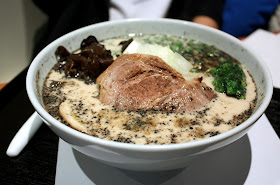-"Raijin was the last place I tried because I heard it's the worst";
-"There's a reason why there's no line up at Raijin"; and
-"I liked Raijin the least out of all the ramen places in Toronto"
So no, I certainly did not have high hopes / expectations going into Raijin but surprise, surprise, after having lunch there a couple of weeks ago, I can say that I really liked Raijin, so much so that I am looking forward to going back soon.
Located at Yonge and Gerrard, Raijin opened in November of last year and is owned by Daiji Matsubara, who also owns the popular ramen shops Kintaro and Motomachi Shokudo in Vancouver. Raijin is known for its tonkotsu (pork bone), toridashi (clear chicken), and its bamboo charcoal black miso ramen.
Raijin is currently the largest ramen restaurant in downtown Toronto with seating up to 80 in its two dining rooms and bar. This really puts into perspective as to why there is no wait, right? Also a related note: people should appreciate the fact that Raijin is also large enough to accommodate people waiting for a table to be able to wait inside the restaurant, rather than forcing people to wait outside unlike the other ramen shops in Toronto. This is extremely important during winter months!
I really like Raijin's interior because it fully takes advantage of its 3,500 sq foot space. Unlike other tiny ramen shops where tables are lined up side by side with very minimal space in between, the seating at Raijin is incredibly roomy and comfortable.
A statue of Raijin, the Japanese god of thunder, in the front dining room.
My two friends and I shared the two appetizers. We each had our own bowl of ramen.
POUTINE DU JAPON ($4.5)
POUTINE DU JAPON ($4.5)
Poutine with Cheddar Cheese Curds and Teriyaki Sauce, Mayo topped with Green Onion, Nori Seaweed
KARA-AGE ($4, small)
Japanese Fried Chicken with a Slice of Lemon
BAMBOO CHARCOAL DARK MISO RAMEN ($11)
Pork Shoulder, Bean Sprouts, Green Onion, Canola Flower, Seasoned Soft-boiled Egg, Chili Pepper Powder.
NOUKOU TONKOTSU SHIO RAMEN ($9.5)
Pork Shoulder, Green Onion, Canola Flower, Black Fungus, Cabbage, 1/2 Seasoned Soft-boiled Egg and House-made Black Oil
KAKUNI RAMEN ($12)
Cubed Braised Pork Belly, Green Onion, Canola Flower, Black Fungas, Cabbage and 1/2 Seasoned Soft-boiled Egg served in a Tonkotsu Shio Soup
I had the Kakuni Ramen which I thought was fantastic. The broth was flavourful, rich and creamy, and not salty. The thick and wavy ramen noodles were bouncy with a perfect chewiness to them (for me anyway). My bowl was loaded with fixin's too so I didn't feel the need to add any sides. With a thick and runny yolk, the egg was cooked just right. The only thing that I see room for improvement is Raijin's pork belly. Yes, there were generous amount of pork belly but I certainly wasn't too crazy about the cut; a couple of pieces were dry with almost no fat. Other fatty pieces were very soft and tender. My friend liked her Noukou Tonkotsu Shio Ramen (she was also pleasantly surprised by Raijin) while my other friend wasn't too thrilled about her Bamboo Charcoal Dark Miso Ramen; she didn't like the taste of the charcoal dark miso. Despite all that, we all rolled out of Raijin stuffed.
You should understand why I like Raijin if you have read my post on Santouka. I'm no ramen snob nor do I claim to be a ramen expert but I know what I like and I appreciate good quality and value. I simply cannot justify spending so much on ramen anywhere because ramen should not be expensive. A quick recap for you: everything at Santouka is an add-on. Their basic ramen bowls come with pork, ramen, broth and a little veg, but they still cost just as much as the basic ramen bowls from Kinton and Raijin, where both ramen shops offer significantly more noodles and different fixin's. Most of Santouka's add-ons also cost more than the add-ons at Kinton and Raijin:
Corn: at Santouka ($2.2), Kinton ($1), Raijin ($1)
Seasoned Egg: Santouka ($1.6), Kinton ($1.5), Raijin ($1.5)
Nori: Santouka ($1.6), Kinton ($1), Raijin ($1)
Really, Santouka? And before you question the quality and the quantity, I can confidently tell you that the corn at Santouka was not twice as sweet nor was there twice as much of it!












